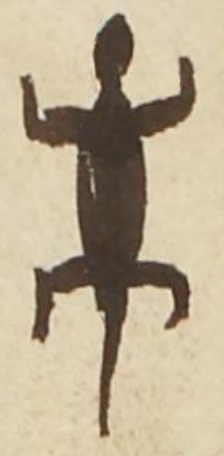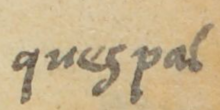Cuetzpal (MH484r)
This simplex glyph for a person's name, Cuetzpal, means Lizard or Iguana. It is a bird's eye view of the outline shape of a lizard, drawn and filled in with black or brown. If not bird's eye, the lizard could also be interpreted to be climbing, upright or vertical. It is painted entirely black.
Stephanie Wood
The historical contextualizing image shows that the man who had this name also had a baptismal name, Felipe. Gordon Whittaker (personal communication, April 2023) suggests that Quetzpal may be a dialectical variant for Cuetzpal. The cuezpalin was a calendrical day sign that some people took as a personal name. Lizards are also commonplace in the landscape of much of Mexico. Other manuscripts have turquoise-colored lizards, and the one in the Codex Magliabechiano has a protruding red tongue. This one may be painted black as a way of providing a clue to the name ending in -pal, which is short for the color black, and therefore may be serving as a phonetic indicator.
Stephanie Wood
quespal
Cuetzpal
Stephanie Wood
1560
Stephanie Wood
lizards, lagartos, iguanas
This bas relief art work (apparently by Daniel Palma) on the facade of a house in Ajijic, Jalisco, seems to feature a lizard or a gecko. Photo by S. Wood, 28 January 2025.

Cuetzpal, a name https://nahuatl.wired-humanities.org/content/cuetzpal.
Quetzpal, a name of a historical personage, https://nahuatl.wired-humanities.org/content/Quetzpal
cuetzpal(in), lizard, https://nahuatl.wired-humanities.org/content/cuetzpalin
pal(li), black clay or the color black, https://nahuatl.wired-humanities.org/content/palli
el lagarto
Stephanie Wood
Matrícula de Huexotzinco, folio 484r, World Digital Library, https://www.loc.gov/resource/gdcwdl.wdl_15282/?sp=47&st=image&r=-0.559,-....
This manuscript is hosted by the Library of Congress and the World Digital Library; used here with the Creative Commons, “Attribution-NonCommercial-ShareAlike 3.0 License” (CC-BY-NC-SAq 3.0).



